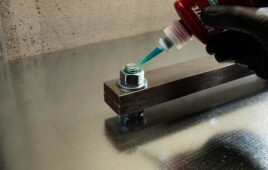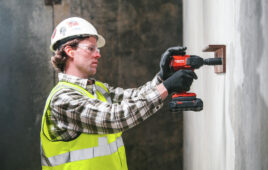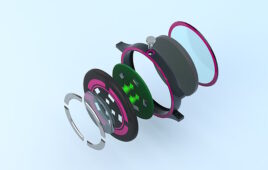
A liquid PSA can be dispensed on the smallest of parts, such as during the assembly of smartphone speakers.
To reliably join two structures, design engineers are typically bound to a few options: mechanical fasteners, welding, or adhesives. Adhesives are often the preferred choice when:
- The weight of an application matters
- The speed of assembly is critical
- Different types of materials require joining
- Assembly tools (such as screwdrivers or drills) are inconvenient or add to the project costs
- An aesthetic appeal is important
Of course, each structure must be assessed individually to determine the ideal fastening method. If adhesives are chosen, the next step is to decide on the best formula based on the assembly requirements. To this end, advances in adhesive formulations are providing design engineers with more options.
Considering PSAs
Conventional pressure-sensitive adhesives, or PSAs, are one type of substance that offers unique characteristics. PSAs are non-reactive and easily bond two components together. These bonds are formed by applying pressure to the adhesive film and surface or substrate of the application, which is advantageous as activation is not reliant on heat, light, water, or solvents.
“Pressure-sensitive adhesives are commonly used in consumer electronics or industrial applications,” explains Dr. Karl Bitzer, head of product management at DELO, a global manufacturer of industrial adhesives. “And, typically in the form of an adhesive tape.”
Such tapes may offer benefits, depending on the application. They can bond dissimilar materials, reduce assembly time, and eliminate the need for mechanical fasteners. Overall, adhesive tapes simplify the assembly and manufacturing processes as they reduce additional steps, such as drilling holes in a structure (for screws) or applying heat (to set certain properties).
However, these tapes also have limitations. “In terms of small and complex geometries, they’re often challenging to apply because of their lack of stiffness and tack-related characteristic,” says Bitzer. Tack is a common term when referring to PSAs (in other words, how “sticky” it is). “For example, tape can be difficult to apply to extremely small structures or those with curves or three-dimensional shapes.”

Compared to conventional pressure-sensitive adhesive tapes, liquid PSAs offer an automated dispensing process and are unlimited by a structure’s shape or geometry.
In such cases, this makes tape applications nearly impossible to automate, increasing the assembly time and efforts. Also, as smaller and more complex structures trend forward — particularly in the electronics sector — such limitations are becoming major drawbacks. Fortunately, there is an alternative solution. The answer lies somewhere between conventional adhesives and PSAs.
“With conventional types of adhesives, a curing mechanism or set temperature is required. Plus, the components are unable to bond by only pressing them together,” he says. “On the other hand, with pressure-sensitive adhesives, a sheet or roll of tape with a liner is provided — and this ‘either/or’ decision can present drawbacks, depending on the application.”
The alternative: “A liquid pressure-sensitive formulation offers an in-between or middle ground, so to speak. It can be applied as a conventional adhesive via a dispensing needle but also has an immediate fixation strength — similar to a conventional PSA. So, it’s really a combination of these two options.”
As their name suggests, liquid pressure-sensitive adhesives offer the advantage of dispensing as a liquid and can be applied directly onto a component. Next, they require irradiation via UV light. This creates a tacky surface, much like tape.
“Since the adhesive reaches its initial strength immediately after the second component is pressed on, the bonded assembly can be processed directly and without any fixing devices. This is a great advantage over many standard liquid adhesives,” says Bitzer.
Liquid options
A variety of dispensing options are also available for liquid pressure-sensitive adhesives, including needle dispensing or jetting for small beads or droplets, as well as stencil or screen printing, or slot-die coating for larger structures (see images of the “processing steps” below). This means automation of the dispensing process is possible, even on an industrial level.

The processing steps of liquid pressure-sensitive adhesives.
Light irradiation (typically 360 or 400 nm) transfers the liquid adhesive into the tape phase within seconds.
“The tape phase is marked by a significant increase in viscosity, preventing any ‘flowing’ of the dispensed pattern, which can happen with conventional adhesives, especially on those complex structures,” says Bitzer.
Since heat is not required for the final curing, the process is also suited for applications where thermal stress must be kept at a minimum. What’s more: after the irradiation is complete, structures cure at room temperature without additional processing.
“Freedom of design is what we’re really talking about here,” he shares. “A liquid adhesive has significant advantages over a tape for structures with those complex shapes or sharp corners. The application process can also be interrupted infinitely. But for tape, such interruptions technically require placing a new piece of tape every single time the liner has been removed. I mean this would be a manual process…and just imagine the assembly time here if there are multiple products.”
Of course, each application should be evaluated to determine the ideal method of assembly. There are cases when a conventional tape may be preferable, such as for large, flat surfaces.
“We first focus heavily on what the problem or requirement is, rather than promoting one product or another. This is because the solution has to best address the structure’s material, shape, and other such features — it’s customized. Liquid PSA simply offers one more choice,” says Bitzer. “Again, this goes back to the freedom of design.”

A comparison of selected features of conventional tapes with liquid pressure-sensitive adhesives or PSAs.
Sustainability in action
Liquid pressure-sensitive adhesives can be used in several applications.
“Housing bonding of electrical components is one common example, of an ideal application. However, there are many others. Think of the speaker area for your smartphone or for a smart-home device,” says Bitzer.
“Sensors are a major component where liquid PSAs are useful. In the automotive industry, sensors are used in several parts for electric vehicles or even autonomous driving, including for radar or LiDAR,” he says. Another example is the ultrasonic sensors found in parking aid systems. The sensor consists of a piezo element that’s bonded into a complex geometry. “Using liquid tape can make the processes easier.”
Another major plus: sustainability. Liquid pressure-sensitive adhesives offer environmental benefits, at least compared to tapes. For one, you’re saving the waste produced by a tape’s mandatory protective liner. Additionally, liquid PSA’s are produced with much lower levels of CO2. This is because the complex and energy-consuming process of applying the adhesive layer to the tape-carrier material via solvents is unnecessary. So, they’re solvent-free.
“If reducing one’s carbon footprint is a goal, which is important in today’s world, liquid pressure-sensitive adhesives offer a ‘cleaner’ choice,” says Bitzer. “Plus, there are different chemical bases with different properties available, further strengthening the freedom of design for engineers.”





Tell Us What You Think!